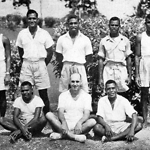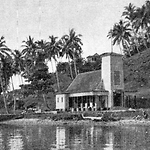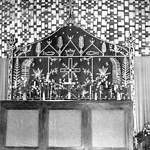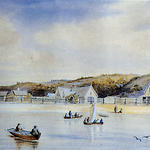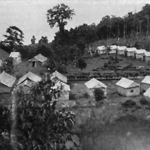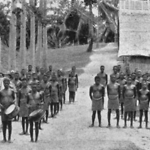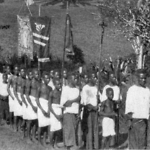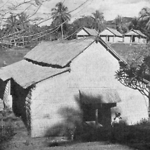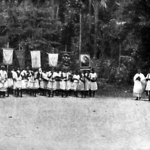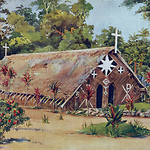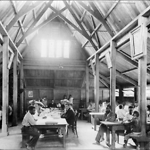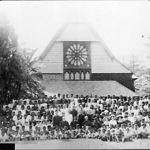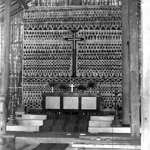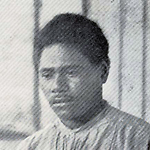Corporate entry: Diocese of Melanesia (Melanesian Mission)
- Functions
- Religion
Details
Often called the Melanesian Mission in its early years, the Church of England (Anglican) missionary Diocese of Melanesia grew out of the personal vision of the first Church of England Bishop of New Zealand, George Selwyn (q.v.), appointed in 1841. The New Zealand Church became the United Church of England and Ireland in New Zealand (1857), then in 1874 changed its title to the Church of the Province of New Zealand. Recently it became the Anglican Church of Aotearoa, New Zealand and Polynesia. The Melanesian Mission was also adopted as a mission by the Australia General Synod, in 1851, making it an Australasian Anglican Mission. The Diocese of Melanesia, like the Diocese of Polynesia, was an associate missionary diocese of the Anglican Church of New Zealand from its formation on 24 February 1861 until the formation of the autonomous Church of the Province of Melanesia in 1975. During this time, the Council of Bishops of the Anglican Church of New Zealand appointed the Bishop of Melanesia, and the Bishop of Melanesia was a full member of the New Zealand Council of Bishops. The New Zealand bishops gave the Diocese of Melanesia a great deal of autonomy, for example, allowing a separate Melanesian Prayer Book. They also consulted with diocesan staff in appointments of bishops. The Diocese of Melanesia ceased to be part of the Church of the Province of New Zealand when the Church of the Province of Melanesian (Church of Melanesia) was inaugurated on 26 January 1975, with Bishop John Wallace Chisholm as the first Archbishop of Melanesia. (Ross 1982)
The concept applied by the Melanesian Mission was to persuade adolescent boys (and a few girls) to leave their islands to be trained at mission schools, where teaching combined evangelism, education and industrial skills, with the aim of returning young men to their villages to establish their own schools. Bishop Selwyn wanted to create 'a black net' (the Islander teachers) supported by 'white corks' (white mission workers), that spread throughout the Pacific Islands. The students after two years away were returned to their homes for six months, and on their return to school were allowed to bring the girl to whom they were betrothed, and to undergo baptism. If all went well, students remained for about eight years.
The first year of the Melanesian Mission was 1849 when five Loyalty Islands youths were brought to St. John's College, Auckland. The school moved in 1859 to St. Andrew's College at Kohimarama in Auckland, and then in 1867 to St. Barnabas' College on Norfolk Island, where it remained until 1920 when it transferred to Siota in the Nggela Islands. The number of students fluctuated but was generally around two hundred. For example, in 1896 there were 159 men, 48 women and 6 children. Their ages varied, but most were in their teens or early twenties. The Norfolk Island school consisted of a beautiful memorial church, a boarding school, a printery and a farm. Island groups also built their own meeting houses in customary styles. (Sohmer 1988)
1840s-1920s
The Mission was always conscious of the distances scholars had to travel and their high mortality rates at the schools from cold and disease, and this was an important factor in the steady move north from Auckland to Norfolk Island to the Solomons. The early schools were combined with the Mission's headquarters and the seat of the bishops. The first medium of instruction was the Mota language from the Banks Group, in present-day Vanuatu. Several attempts to replace Mota with English failed and the change was not made until 1930.
Bishop Selwyn visited the islands regularly from 1849 with the aim of taking boys back to his school in New Zealand, but success was slow. He would go ashore and walk into a village, give away trade goods and ask if he could take a youth back to his school. Usually people refused the first time, but when he returned the next year he was often successful. The first Solomon Islander to go through an Anglican baptism was William Didimang (q.v.) from Arosi on Makira, brought to Sydney by Captain Erskine on HMS Havannah in 1850 with some other boys, and handed over to Selwyn. The first mission recruits were obtained from Makira in 1852 when Selwyn visited the Solomon Islands on the Border Maid. An early form of Pijin English was already in use around Makira, presumably introduced by whalers. Selwyn was generous with his gifts and does not seem to have had any difficulty persuading the Makira people to part with young boys for his school, particularly after Didimang returned safe and sound. By 1855, there were several boys from the Arosi area at St. John's School, five of them from Mata, among them Sumarua and Stephen Taroaniara (q.v.). These boys were returned to Makira but had returned to customary worship when Rev. Richard Comins (q.v.) met them in the late 1870s; they still remembered the hymns and their adventures in New Zealand.
The Mission continued to visit the Solomon Islands and persuade youths to join the schools, using a series of ships. The main vessel from 1855 on was always called the Southern Cross (q.v.). For instance, Bishop Patteson (q.v.) visited Guadalcanal in 1857, taking two youths away to school, and Ulawa in 1860-1861, taking six youths and two of their young wives. His first real success on Ulawa was with Walter Waaro (q.v.) who left the island in 1870 and returned to found a school there in 1880. Patteson also first visited Isabel Island in 1861, and Nggela in 1862. Joseph Wate'ae'pule, (or Wate) (q.v.) and Watehou from Small Malaita, and Charles Sapibuana (q.v.) from Nggela underwent the same recruitment process in 1866. The first attempt at forming a permanent base in the Solomon Islands was in 1862 on Santa Cruz.
The first Bishop of Melanesia was John Coleridge Patteson, consecrated in 1861, which relieved Selwyn of his northern duties, but Patteson was killed at Nukapu, an atoll in the Reef Islands, in 1871. This was traumatic for the Melanesian Mission and heldback its agenda in the Reefs for many years. Patteson had first visited Nggela in 1862, beginning to take boys to Norfolk Island. The first successful mission base in the Solomon Islands was at Mboli on the east coast of Nggela, where, starting in 1869, Charles H. Brooke and Joe Atkin stayed for several months each year, but for the next few years people there were hostile because of the Sandfly (q.v.) and Lavinia (q.v.) massacres. By 1873, the first Nggela Prayer Book was published and permanent village schools were established at Polomuhu (Mboli), with Dudley Laukona as teacher. A school was started at Langgo (Gaeta) in 1877, with Charles Sapibuana as teacher. Rev. Alfred Penny conducted the first baptisms on Nggela in 1879. (Penny 1888)
The Anglicans established a permanent base at Wango, Makira in 1870, with Maurice Oha as teacher, and started another at Fagani under Harper Mara. The first baptisms there occurred in 1875, and seven boys and one girl were sent to Norfolk Island for further education. By 1894, there were 135 Christians on Makira. The Mission took strong hold in the Nggela Islands after Bishop John Selwyn made inroads due to his handling of an 1880 incident concerning the murder of crew from HMS Sandfly (q.v.). In 1884, there were six hundred baptisms, with 2,000 more were added to the church on Nggela by the early 1890s. By the time the British Resident Commissioner was established at Tulagi in 1897, Nggela was home to between four and five thousand Christians, thirty-three schools and almost a hundred teachers, all led by two deacons, Reuben Bula and Alfred Lobu, and supervised by Rev. C. W. Browning. A boy's school was established at Siota (q.v.) at the western end of Nggela's central channel in 1896. For a time there was a possibility that the Melanesian Mission might also begin a hospital there, which would have obviated the need for a large hospital on Tulagi, but this came to naught.
From its beginnings on Nggela, during the 1870s and 1880s the Mission reached out to Savo, Isabel, and Guadalcanal and on occasions to west Malaita. Missionaries usually only spent six months of each year at their island mission, then returned to headquarters for recuperation. It took thirty years to establish the mission on Savo. Two Mota missionaries, John Ngongono and Andrew Lalenga, began a school on Savo in 1870, Mano Wadrokal (q.v.) established a school for Isabel people living on the island in 1872, and a Savo man trained at Norfolk Island began a school there in 1879. David Ruddock spent several months on Savo between 1879 and 1881. Even in 1900, Savo people still rejected Christianity and were influencing people of nearby Guadalcanal against the Mission.
Bishop Patteson had visited Guadalcanal during 1856-1858, but after his death in 1871 there were no further attempts there until the 1883, when Ruddock and two brothers, Hugo Ngorovaka (q.v.) and George Basilei, walked from near present-day Honiara to Savule near Maravovo at the northern end of the island. They were not welcomed and withdrew. As children, Basilei and Ngorovaka had been taken as slaves from Vaturanga on the coast in west Guadalcanal, first to Savo and then to Isabel. They managed to rejoin the Melanesian Mission and were sent to be educated at Norfolk Island. They returned home again in 1896-1897 to begin a school on their land at Maravovo. They were joined in 1898 by Percy Henry Williams, who had missionary experience around Bundaberg in Queensland, and a dozen Nggela men with Queensland and Norfolk Island mission experience. After initial hardship, and strident opposition from local bigman Sulukavu-in 1896 they had to evacuate to Savo-this time the Mission was successful, with the first baptism in 1901. Hugo Ngorovaka became the mainstay of the settlement, based at Tetepare, six kilometres inland from Vaturanga. Paringala was the first Guadalcanal man to be sent to Norfolk Island, in 1897, and several followed in subsequent years. Sulukavu finally accepted their presence in 1907, and by 1909 schools existed along the coast on both sides of Maravovo.
Isabel Island became another cornerstone of the mission, although officially it remained part of German New Guinea until 1899. Patteson first visited in 1861 and the first Isabel student went to Norfolk Island the next year. The Bishop had developed a familiarity with one local language by 1866. Wadrokal in 1874 moved his school from Savo to Nuro on Isabel, assisted by Isabel youths trained at Norfolk Island. Progress was slow until bigman Bera (q.v.) died in 1883, and bigman Soga (q.v.) was converted in 1889, which enabled the mission to spread quickly and a school to start in his Sepi village. Dr Henry Welchman was priest in charge from 1890 to 1901.
Santa Cruz was an early port of call- Patteson first went there in 1856-but was also one the hardest islands on which to establish the Mission. In 1859, Moto, a Nukapu chief, visited the Kohimarama School in New Zealand, and Patteson visited Santa Cruz again in 1862 and 1864, but was attacked and two companions were killed. Patteson had been killed on nearby Nukapu in 1871 and Commodore Goodenough of the Royal Navy Australia Station was killed at Santa Cruz in 1875. Bishop John Selwyn returned castaways to the Reef Islands in 1877, and placed Mano Wadrokal and his wife on Santa Cruz in 1880. They remained there for five years and schools began to flourish. The first European missionary on Santa Cruz was Lister Kane in 1882-1885, replaced by Sam Gede of Makira in 1886 and Ben Islavno from Motlav (Motalava) in 1887. Lay missionary A. E. Forrest worked there in the 1890s, proving himself a gifted linguist.
Malaita was also proved a hard island on which to establish Mission bases, although Bishop Patteson was well received when he visited Olaha on Small Malaita in 1856. During the 1870s and 1880s missionaries based at Nggela had occasional contact with Malaita's west coast. The first Christian teacher on the island (at Sa'a on Small Malaita) was Joseph Wate, there in 1877 for a short while, trying again in 1884-1885 and moving there permanently from 1890. Walter Ivens began a mission to Small Malaita in 1895, from his base on Ulawa. In 1899-1900, the mission tried to open at 'Ataa at the southern end of Lau Lagoon, based on the many returned labourers from Queensland there, and attempted to get the support of Kwaisulia (q.v.), who was the most powerful man in the Lagoon and wanted a European missionary. At Fiu on the west coast there was already a settlement of twenty Christian men with a small church, which had struggled along for several years, and another Christian settlement was at Port Adam on Small Malaita. Arthur Hopkins began a mission at Ngorefou on the mainland side of Lau Lagoon in 1902. Stockades were built for protection and armed guards were needed to safeguard worshipers and even ordinary activities.
The Mission's expansion into the northwestern Solomons was brief. A school began on Choiseul in 1901, but the Methodist Mission (q.v.) arrived on New Georgia in 1902, and in 1907 the Melanesian Mission abandoned the region. A school was established on Laube Island in the Russell Islands in 1905. Bishop Patteson first visited Tikopia in 1857 and again in 1862, but it took until 1901-1902 for Motalav and Maori teachers to begin a school there. Tikopian Christians took the gospel to Anuta (q.v.), another island 112 kilometres away. Utupua and Vanikolo in the Santa Cruz Islands were visited by Selwyn in 1856 and by another missionary in 1895, but no permanent mission school was established until 1904. Boys from isolated Rennell and Bellona went with Patteson to New Zealand in 1856, Bishop Wilson (q.v.; 1894-1911) visited there twice, and Bishop Baddeley (q.v.; 1932-1947) called several times after 1938. Finally, people of the two islands accepted the SSEM (q.v.) and the Seventh-day Adventists (q.v.). Sikaiana Atoll (q.v.) became Anglican in 1930, followed by Ontong Java (Lord Howe Atoll) (q.v.) in 1934.
The Mission's main bases were on the islands of Makira, Ulawa, Malaita, Nggela, Savo, Isabel and Guadalcanal. St Luke's, the first junior boarding school for boys in the Protectorate, was established at Siota (q.v.) on Nggela in 1896, with forty students. Other auxiliary training schools were created at Lilihigna on Isabel Island, Sanlang in Vureas Bay, Vanua Lava in the Banks Group in 1905, Bungana (q.v.) on an island in the Nggela Islands in 1910, at St. Michael's (q.v.), Pamua, on Makira in 1911, and at Veranaaso (Maravovo), Guadalcanal. This last site began as a theological college (1916), which was shifted to Siota, then became a technical college (1920), and in 1922 was converted to St. Mary's Girls' School (q.v.). The next boarding school for boys was St. Barnabas', opened in 1936 at Alangaula on Ugi Island (q.v.), followed by Litogahira School (q.v.) on Isabel Island in 1945. All Hallows' Senior School at Pawa (q.v.) on Ugi Island began in 1922 after the senior school was transferred from Norfolk Island. The first boarding school for girls was opened at Boromole on Nggela in 1917, then moved to Siota the next year (named St. Hilda's), and finally was moved to Bungana in 1920. The second girls' school, Selwyn College, was established at Torgil on Vanua Lava in 1920. Siota Theological College was transferred to a new site at Kohimarama in 1967. (Fox 1958, 225-247)
Transfer to Siota, 1920
The first Anglican hospital was built on Norfolk Island, and operated until the Mission transferred its headquarters to Siota in the Solomons in 1919. The Welchman Memorial Hospital opened in 1912 at Hautabu, Maravovo, but closed in 1916 when the doctor left to support troops in the First World War. The building became the mission printery, the first printing press in the Solomon Islands having been installed there in 1912 (q.v. Printing Presses). Plans began in 1927 to build a second hospital, at Fauabu on Malaita, and it opened in 1929 as the Hospital of the Epiphany. Half the patients were Anglican and the remainder were from other denominations or non-Christians. A settlement for leprosy patients was established at nearby Kwaiba'ita. Nurse training began at Fauabu in 1941. The hospital reopened after the war and the Nurses' School, which offered a four-year course, became an important part of its activities. The next hospitals were established in 1937 at St. Barnabas' at Kerepei on Ugi Island and St. Luke's at Aoba (Ambae) Island in the New Hebrides (Vanuatu). The first Anglican Cathedral in the Solomons was constructed at Siota in the 1920s. The Melanesian Brotherhood (q.v.) was formed in 1925.
A major part of the Mission's task was the translation of the Bible, a prayer book, and other books into Melanesian languages. Mota was adopted as the mission's lingua franca from the 1860s to 1917, and then a change to English was tried. This faltered, though English did eventually become the Mission's language in 1930.
During the early twentieth century new dioceses were established in the Pacific. Colonial Queensland had three, which became the Province of Queensland in 1904, with New Guinea attached as a missionary diocese under the jurisdiction of the Archbishop of Brisbane. The first Anglican missionaries reached New Guinea in 1891, and in 1897 Montagu John Stone-Wigg was consecrated the first Bishop of New Guinea, the Diocese concentrated in the tail of east New Guinea. In 1920, moves were made to expand the Diocese of Melanesia to include the Bismarck Archipelago and Bougainville, but this proved impossible because the Methodists and Catholics had already established bases in the areas of proposed extension, and because the Melanesian Mission lacked the necessary staff and funds, even with Australian assistance. In 1908, Fiji was incorporated into the Diocese of Polynesia, as was the previously unattached Diocese of Hawaii, compromised after the American annexation of the Hawaiian Islands. Fiji separated in 1923. A third diocese for New Britain and New Ireland within the New Guinea Mandated Territory began in 1928. Once German New Guinea became a Mandated Territory of the League of Nations, the islands portion was attached to the Diocese of Melanesia. The last expansion of the activities of the Diocese of Melanesia was into part of southwest New Britain, which after the Second World War was passed to the local diocese. The New Guinea islands became an integral part of the Diocese of Melanesia, titled the Northern Archdeaconry. An Assistant Bishop was appointed and consecrated, E. N. Wilton, but he remained only a short time. Another Bishop was not appointed, the supervision being done by the Archdeacon of Northern Melanesia. Diocesan oversight and work also spread to the former German New Guinea mainland, especially around Wau and Bulolo where there was gold mining and a substantial expatriate population. The centre of work was always St. George's parish, at Rabaul, New Britain, with its large expatriate community, although there was also substantial work with local congregations on the south shore of New Britain. After the Second World War the archdeaconry was turned over to the Diocese of New Guinea.
In 1920, the diocesan headquarters and theological college were transferred to Siota on Nggela. St. Luke's Cathedral was consecrated at Siota in 1928. By the time the Second World War arrived, the Mission had fourteen district schools in the Solomon Islands. Most of the clergy left at the outbreak of the war, although Bishop Baddeley and a small group stayed on in hiding, living in the Malaita mountains in the early months, before returning to Baddeley's headquarters at Taroaniara on Nggela after the Americans arrived. All Hallows' School at Pawa (q.v.) and St. Barnabas' School at Alangaula (q.v.) , both on Ugi, continued to operate. St. Mary's School, although its Maravovo site was destroyed, operated from Gwaigeo near Fiu, Malaita. The Melanesian Brothers continued their work in Lau Lagoon. Baddeley was appointed Chaplain and Lieutenant-Colonel to the Fijian Battalion and the New Zealand Navy. His refusal to leave increased his mana with Solomon Islanders, and he was admired by the Allied troops, particularly among the Americans. (Baddeley 1942)
To summarise the key personnel, there were three early Archdeacons of the Solomon Islands: Richard Comins (1903-1910), William Uthwatt (1910-1916) and Harry Reynolds (1902-1978). The first Bishops were Selwyn (1849-1861), Patteson (1861-1971), Selwyn (1877-1891), Wilson (1894-1911), Wood (1912-1918), Steward (1919-1928), Molyneux (1928-1931), Baddeley (1932-1947), Caulton (1948-1953), Hill (1954-1967) and Chisholm (1967-1975) (all q.v.).
(NS May 1961; Montgomery 1904, ch. 20; Fox 1958; Edridge 1985, 215; Wilson 1932, 194-251; Wetherell 1977, 52, 329; Terry Brown, personal communication, Aug. 2010; Ivens 1918, 170-171; SCL Nov. 1896, 1, Dec. 1896, 10, 15 Aug. 1898, 5, 15 Feb. 1900, 25-31, Apr. 1906, 3-4, June 1909, 28)
Honiara, 1940s-1970s
After the Second World War, the diocesan headquarters was moved to Guadalcanal when Honiara was established. Bishop Sidney Caulton replaced Baddeley in 1948. St. Luke's Cathedral at Siota was destroyed during the war and All Saints' Cathedral was constructed in Honiara out of two Quonset huts. That served well enough until the present St. Barnabas' Cathedral (q.v.) was built in 1968-1969. The theological college remained at Siota until 1969, when it was moved to Kohimarama, west Guadalcanal, where it became Bishop Patteson Theological Centre (later College). One postwar trauma was when the Sisters of the Cross (q.v.), who had served in the islands since 1927, left to join the Catholic Church.
In May 1961, Bishop A. T. Hill was given authority to appoint Solomon Islands priests as Assistant Bishops. On 30 November 1963, he consecrated the first two Melanesian Bishops, Leonard Alufurai and Dudley Tuti, who became Assistant Bishops for the Eastern Solomons and the Central Solomons, respectively.
When Bishop Hill retired in June 1967, a Sacred Synod was held in Honiara to consider the Diocese's recommendations to the Archbishop of New Zealand on the choice of a successor. The Archbishop and Bishops of New Zealand elected Rt. Rev. John Wallace Chisholm, Assistant Bishop of New Guinea, as the tenth Bishop and his enthronement took place in Honiara on 24 September 1967. In October, Leonard Alufurai (q.v.) was appointed Bishop of the Eastern Solomons and Dudley Tuti (q.v.) Bishop of the Central Solomons, both Bishops holding Episcopal and archidiaconal jurisdiction in those areas.
The foundation stone for St. Barnabas' Cathedral (q.v.) was laid in 1961 and the final building was consecrated on 16 June 1969. (AR 1968, 82, AR 1969, 80-81) The temporary cathedral site was redeveloped as a Diocesan Centre, a women's hostel was started and houses were set aside for two religious communities which came to the Diocese in 1970, the Society of St. Francis and the Sisters of the Church (q.v.). The Diocesan Centre building was begun in October 1969 to provide office space for the Diocese and the Diocesan Department of Education. Recreational facilities, a bookshop, counselling rooms and a base for the work of the Franciscan Friars and the Sisters of the Church were provided. The first phase was opened in mid-1970. At the end of 1967, building began on the new girl's school at Bunana on Nggela, and the plan for a full range primary school-St. Nicholas', Kukum-was advanced with the building of four classrooms. All Hallows' School at Pawa (q.v.) on Ugi Island became a secondary school in 1967. Other extensive building projects commenced during 1967 to replace houses, schools and hospitals damaged in a cyclone that year. The Printing Press, Joinery and Engineering Departments at Taroaniara were improved, and the enrolment at St. Andrew's Catechist College increased. The Melanesian Brothers sent groups to work in New Guinea, New Britain and Polynesia, as well as throughout the Diocese. (AR 1967, 78)
The Church relied on its small fleet to maintain communications with its bases in the Solomons and the New Hebrides. The main ships were the nine different vessels called Southern Cross (q.v.), but there were also smaller vessels such as the thirty-year-old Mavis, an ocean-going launch about 8.5 metres long, and the nine-metre launch Tuti, which Americans gave to the Mission to replace one lost in the war, and was used to carry cargo. The Patteson, a 13.7 metre ocean-going vessel, became the main ship. Later, the Baddeley joined the fleet, a 15.8 metre Australia-built cargo boat, as did the Fauabu-Twomey, a gift from the Leprosy Trust Board, which serviced the leprosarium and did general cargo duty. (Montford 1994, 87)
The Melanesian Bishops began to travel overseas. In 1966, Bishop Alufurai paid a month's visit to America at the invitation of the Protestant Episcopal Church of America, and Bishop Tuti spent three months in England at the invitation of the Diocese of Melanesia English Committee. There Bishop Tuti preached in cathedrals and parish churches and was presented to the Queen by the Secretary of State for the Colonies. (AR 1966, 69) In 1967, Bishop Alufurai undertook an extensive reputational tour in Australia and Bishop Tuti visited Tonga for the consecration of the Assistant Bishop of Polynesia. (AR 1967, 79)
In 1968, funds were collected for and construction began on a new co-educational secondary school at Najilagu, to be called Selwyn College. Theological training for lay and ordained ministers was centred at Kohimarama at the Bishop Patteson Theological Centre, where an extensive building programme began in July. The plan was to make Siota a senior primary school for Nggela, and to begin a new training centre for clergy, catechists and lay workers at Fiu, Malaita. The Training College at Taroaniara was expanded and at Fauabu Nurses Training Centre a new scheme of medical training was worked out to meet the demands of Fauabu and diocesan clinics. (AR 1968. 84)
In 1969, before the consecration of the new Cathedral, a Diocesan conference was held at King George VI School (q.v.) to make decisions about the future. Plans were made to hand over junior primary schools to local authorities at a time to be agreed upon between the Anglican Church and the government. New types of ministry were planned for scattered islands, and it was stressed that English would be the major medium of communication, while local languages would also be retained. Two scholarships for students proceeding to tertiary education overseas were created to honour the life of Rev. Canon Dr Charles Fox (q.v.; 1878-1977), who had worked in the Diocese since 1901. A Holy Year was announced to begin on 20 September 1970 in preparation for the centenary of the martyrdom of Bishop John Coleridge Patteson. (AR 1969, 81)
During 1970, eight new permanent churches were constructed and dedicated on Nggela, Isabel, Savo and Guadalcanal, and new permanent schools were erected at Jejevo, Bubaba and Ugi. In January, the new co-educational secondary school-Selwyn College-was opened with two hundred students and a staff of nine. The cost of $120,000 was paid for by donations from New Zealand, England and the United States. In March, the Bishop Patteson Theological College was opened at Kohimarama to replace St. Peter's Theological Centre, which became a senior primary school for boys and girls on Nggela. This Centre provided a four-year course for men seeking Holy Orders, refresher courses for clergy, and training for men as evangelists, with plans to later include women. The Centre had a staff of five full-time and three part-time lecturers, and forty-two students. In June, four friars of St. Francis started social and pastoral work in Honiara, and in December three Sisters of the Church joined them. A new building to accommodate them had been constructed at the Diocesan Centre and was named in honour of Bishop Patteson. Events to mark the Patteson Holy Year were held every month for twelve months until September 1971. A new ship, the Charles Fox, was constructed at Taroaniara. Ten students sponsored by the Diocese attended tertiary institutions overseas. Twelve men were ordained during the year by the Diocesan Bishop and his two assistants. A new overseas scholarship was made available, to honour the memory of Bishop Hill. Nurse training continued at Fauabu Hospital and manual training at Taroaniara, and two Island Training Centres for catechists were established on Malaita and Isabel. At the end of 1970, 120 Melanesian Brothers were at work in the Solomons, the New Hebrides, Fiji and New Guinea. (AR 1970, 89)
1971 was an important year for the Church, with the celebration of the centenary of the martyrdom of Bishop Patteson. Preparations begun three years earlier in Melanesia had aroused considerable interest in Australia, New Zealand and Britain. The Postal Department issued a set of commemorative stamps. Special services were held each month at St. Barnabas' Cathedral (q.v.), and three plays were produced there: No Fault to Find by the Honiara Hams, and Noah's Flood and Murder in the Cathedral by students of Selwyn College. Special visitors came from overseas for the celebrations, which ended with a pilgrimage of representatives from all islands to Nukapu, and a great thanksgiving service on 26 September at the Cathedral, with the Primate of Australia as the preacher. His sermon was noteworthy in that he apologised to the congregation for the damage done through 'blackbirding', the nineteenth-century Queensland labour trade. At the service, a thanks offering was given for the new church at Luesaleba, Santa Cruz, and the Bishop Patteson Theological College at Kohimarama.
In January 1971, the Church made good its promise to begin the transfer of its junior primary schools to the Local Councils, with the handing over of all junior primary schools on Isabel to the Santa Isabel Council. In October, one of the Church's long-serving and loyal teachers, Joan Beglen, died after a short illness. She had served the Diocese for twenty-one years, first at St. Mary's Girls School, Pamua, Makira, and later as the Church's Education Secretary.
The building programme continued. The Diocesan Centre complex of buildings was completed with the erection of a new store and printing office. In December 1971, the Memorial Chapel to the late Bishop Alfred Hill was dedicated to All Saints and consecrated by the Bishop. On 25 September the High Commissioner opened new buildings at the Bishop Patteson Theological Centre. The Centre was granted the right by the South Pacific Association of Theological Schools to give certificates and diplomas, with reciprocity with similar institutions in other parts of the world. Fifty students were in residence in 1971 and ten men had been ordained to the ministry. New churches constructed with permanent materials were built on Nggela, Santa Cruz, Sikaiana, Guadalcanal, Savo, Malaita and Isabel, and new wards were added to Fauabu Hospital on Malaita and St. Clare's Hospital at Taroaniara. (AR 1971, 98-99)
The year 1972 was difficult because the Protectorate suffered extensive cyclone damages. The Anglican Diocese expended $25,000 in relief to village people, grants to rebuild churches and personal grants to help clergy who had lost possessions. Churches in Australia, New Zealand and England were generous in providing help. Despite this setback, progress was made in other areas. The Diocesan Centre in Honiara was further extended by the completion of a new All Saints' Chapel, and workers completed a new annexe to the transit house and two new buildings for staff accommodation. An assembly hall was built at St. Nicholas' School and many new buildings were completed at Selwyn College, financed by friends of the Church and the British government under the Sixth Development Plan. As a result of a request made through the Solomon Islands Christian Association (q.v.), West Germany granted $20,000 to equip the Diocese's printing press with the most modern offset printing facilities in the South Pacific. This, along with several other pieces of equipment, provided the Diocese and community with an advanced printing service.
Theological training was maintained at a high level, and the Bishop Patteson Theological Centre was accredited by the South Pacific Association of Theological Colleges and the Melanesian Association of Theological Colleges. Fifty-two students were in residence, and during the year, seven were ordained to the priesthood and fourteen to the diaconate. New dormitories, a staff house, a permanent water supply and ablution blocks were erected.
Several of the senior primary schools became co-educational, and the former St. Mary's Girls School at Pamua was handed over to the local church community on Makira to be run as a community training centre for men and women. There were similar plans for Tasia School on Isabel. Medical work was continued at the maternity hospital at Taroaniara at Kerepei on Ugi, on school dispensaries, and at Fauabu, where a high level of nurse training was maintained with the approval of the Nurses and Midwives Board. (AR 1972, 105-106)
When the Diocesan Conference met in January 1973, it was unanimously decided that the Church should become an independent province of the Anglican Community. A draft constitution was widely discussed and sent to London and New Zealand for comment and approval. The constitution gave the Church in Melanesia the right to order its own affairs, appoint its own bishops, set its own liturgy and discipline, and divide the Diocese into four new ones: Ysabel (Isabel), New Hebrides, Malaita and Central Melanesia.
The Diocese continued to separate itself from lower-level education, and the Diocesan Conference agreed to withdraw from financial responsibility for junior primary education starting on 1 January 1975, and thereafter to gradually withdraw from senior primary education. Building continued at higher education institutions. A new two-storied classroom block was completed at Selwyn College with funds provided by the Sixth Development Plan. New dormitories were also erected at Selwyn and several senior primary schools. A new chapel was completed and consecrated at Bishop Patteson Theological College in memory of the martyred Bishop, and a new women's residence hall was dedicated to the memory of Naomi Tuti, the wife of Bishop Tuti. This enabled women students to attend for the first time. The College also erected a large modern dining hall and a recreation hall, named in honour of Sir Michael Gass, and a new clinic, two permanent dormitories and an ablution block.
During the year, twenty-three men were ordained to the diaconate and twelve to the priesthood, and thirty novices were admitted to the Melanesian Brotherhood. Medical work continued at the Taroaniara Maternity Hospital, where Matron C. Woods completed forty years of medical service in the Protectorate, and also at Kerepei on Ugi and at school dispensaries. Work was also ongoing at Fauabu, where nurses training continued with the approval of the Nurses and Midwives Board. Also in 1973, Rev. Canon Dr Charles E. Fox (q.v.) left the Diocese after seventy years of service in Melanesia. Fox had served in many posts and published several books, including histories, languages dictionaries in Nggela and Arosi and many Bible translations. (AR 1973, 110)
In 1975, upon the formation of the Church of Melanesia, Leonard Alufurai became the first Bishop of the Diocese of Malaita and Dudley Tuti the first Bishop of the Diocese of Ysabel. The Bishop of Melanesia, John Wallace Chisholm, became the Bishop of Central Melanesia and Archbishop of Melanesia. Bishop Derek Rawcliffe (q.v.), already Assistant Bishop of Melanesia for the New Hebrides since 1974, became the Bishop of the New Hebrides. (I thank Terry Brown for his assistance with this entry.)
Related entries
Published resources
Books
- Edridge, Sally, Solomon Islands Bibliography to 1980, Institute of Pacific Studies, University of the South Pacific; Alexander Turnbull Library; Solomon Islands National Library, Suva, Wellington & Honiara, 1985. Details
- Fox, Charles E., Lord of the Southern Isles: Being the Story of the Anglican Mission in Melanesia, 1849-1949, Mowbray, London, 1958. Details
- Ivens, Walter G., Dictionary and Grammar of the Language of Sa'a and Ulawa, Solomon Islands, Carnegie Institution, Washington, 1918. Details
- Montford, C.L., The Long Dark Island, The Desk Top Press, Wellington, 1994. Details
- Montgomery, Henry H., The Light of Melanesia: A Record of Thirty-Five Years Mission Work in the South Seas, Written after a Personal Visitation made by Request of the Right Rev. John Selwyn, D.D., late Bishop of Melanesia, Originally published: 1896, Society for Promoting Christian Knowledge, London, 1904. Details
- Penny, Alfred, Ten Years in Melanesia, Originally published: 1887, 2nd edn, Wells Gardner; Darton, London, 1888. Details
- Wetherell, David, Reluctant Mission: The Anglican Church in Papua New Guinea, 1891-9142, University of Queensland Press, St Lucia (Qld), 1977. Details
- Wilson, Cecil, In The Wake of the Southern Cross: Work and Adventures in the South Seas, John Murray, London, 1932. Details
Journals
- British Solomon Islands Protectorate (ed.), British Solomon Islands Protectorate News Sheet (NS), 1955-1975. Details
Journal Articles
- Ross, R.M., 'Evolution of the Melanesian Bishopric', New Zealand Geographer, vol. 16, no. 1, 1982, pp. 122-145. Details
Reports
- Southern Cross Log (SCL). Details
- Baddeley, Walter H., Behind It All Is God: the Melanesian MIssion in War-Time. The Bishop's Report for 1942, The Australian Board of Missions, Sydney, 1942, 7 pp. Details
- British Solomon Islands Protectorate, British Solomon Islands Protectorate Annual Reports (AR), 1896-1973. Details
Theses
- Sohmer, Sara H, 'A Selection of Fundamantals: The Intellectual Background of the Melanesian Mission of the Church of Englanbd, 1850-1914', PhD, University of Hawai'i, 1988. Details
Images
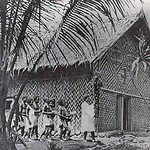
- Title
- A'ame Anglican church All Saint's Day procession, north Malaita.
- Type
- Image
- Date
- 1933
- Source
- Ian Hogbin
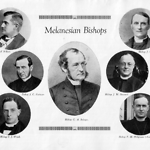
- Title
- Anglican Bishops Cecil Wilson, J.C. Patteson, C.J. Wood, G.A. Selwyn, J.R. Selwyn, L.M. Steward and F.M. Molyneux.
- Type
- Image
- Date
- 1920s
- Source
- DOM
